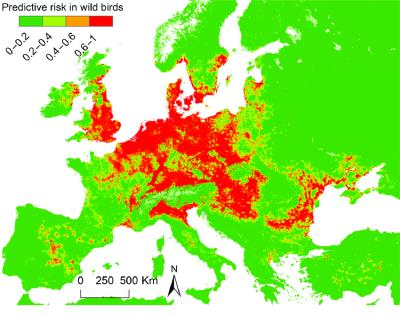 ProMed reported on outbreaks of H5N1 highly pathogenic avian influenza in Poland and Germany during mid-July. The first recent outbreak was confirmed on a farm on Gizyce in the Province of Wielkopolskie in Central Poland. Close to 40,000 birds (type not specified) were depopulated. The case in Germany involved 13,000 geese on a farm in Beverstedt near Cuxhaven in the State of Lower Saxony.
ProMed reported on outbreaks of H5N1 highly pathogenic avian influenza in Poland and Germany during mid-July. The first recent outbreak was confirmed on a farm on Gizyce in the Province of Wielkopolskie in Central Poland. Close to 40,000 birds (type not specified) were depopulated. The case in Germany involved 13,000 geese on a farm in Beverstedt near Cuxhaven in the State of Lower Saxony.
The 2021-2022 epornitic now includes 2,398 confirmed outbreaks in commercial poultry resulting in the depopulation of 46 million birds. Diagnostic laboratories have confirmed H5N1 in 2,733 cases involving wild birds in 36 European nations.
It was determined that 86 percent of the outbreaks in commercial poultry were due to farm-to-farm spread. This was especially evident in France that recorded 68 percent of outbreaks and also in Hungary with 24 percent of cases in commercial poultry. Wild bird isolations were most frequently reported by Germany, the Netherlands and the United Kingdom. The fact that there was a negative correlation between the number of wild bird isolates and commercial outbreaks in the same region may relate to selection bias or the intensity of surveillance of wild birds compared to the protective effect of high levels of biosecurity applied to confined commercial flocks. All E.U. H5N1 isolates examined belong to clade 2.3.4.4b and were identical to isolates from wild mammals including foxes in Canada, the U.S. and Japan.
 The persistence of H5 avian influenza in Europe and the most recent cases in turkeys in Utah during mid-July suggest dissemination of the virus by domestic wild birds since there is minimal movement of migratory waterfowl at this time. This reality presupposes an alternative to traditional methods of control given that H5 avian influenza is no longer an exotic infection in many countries with intensive poultry populations. Persistence of infection requires a high level of biosecurity guided by evaluations of outbreaks. The application of both classical epidemiology and molecular analysis could identify routes of introduction of virus onto commercial farms. Surveillance of wild birds should now be an ongoing exercise no longer restricted to seasonal evaluation of migratory waterfowl. A range of birds under surveillance should be extended to domestic species. It is evident that highly pathogenic avian influenza and specifically the H5 clade now prevalent on four continents has become the Newcastle disease of 2020’s requiring a different approach to prevention.
The persistence of H5 avian influenza in Europe and the most recent cases in turkeys in Utah during mid-July suggest dissemination of the virus by domestic wild birds since there is minimal movement of migratory waterfowl at this time. This reality presupposes an alternative to traditional methods of control given that H5 avian influenza is no longer an exotic infection in many countries with intensive poultry populations. Persistence of infection requires a high level of biosecurity guided by evaluations of outbreaks. The application of both classical epidemiology and molecular analysis could identify routes of introduction of virus onto commercial farms. Surveillance of wild birds should now be an ongoing exercise no longer restricted to seasonal evaluation of migratory waterfowl. A range of birds under surveillance should be extended to domestic species. It is evident that highly pathogenic avian influenza and specifically the H5 clade now prevalent on four continents has become the Newcastle disease of 2020’s requiring a different approach to prevention.